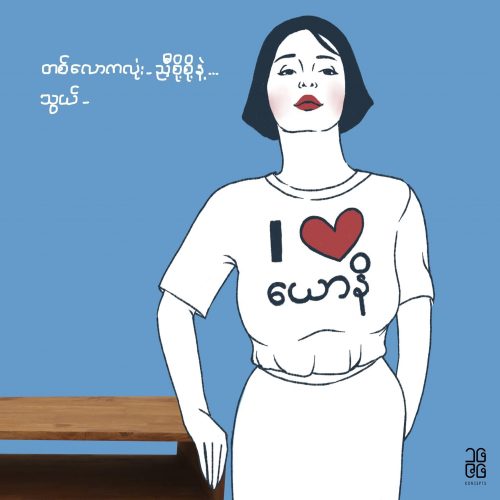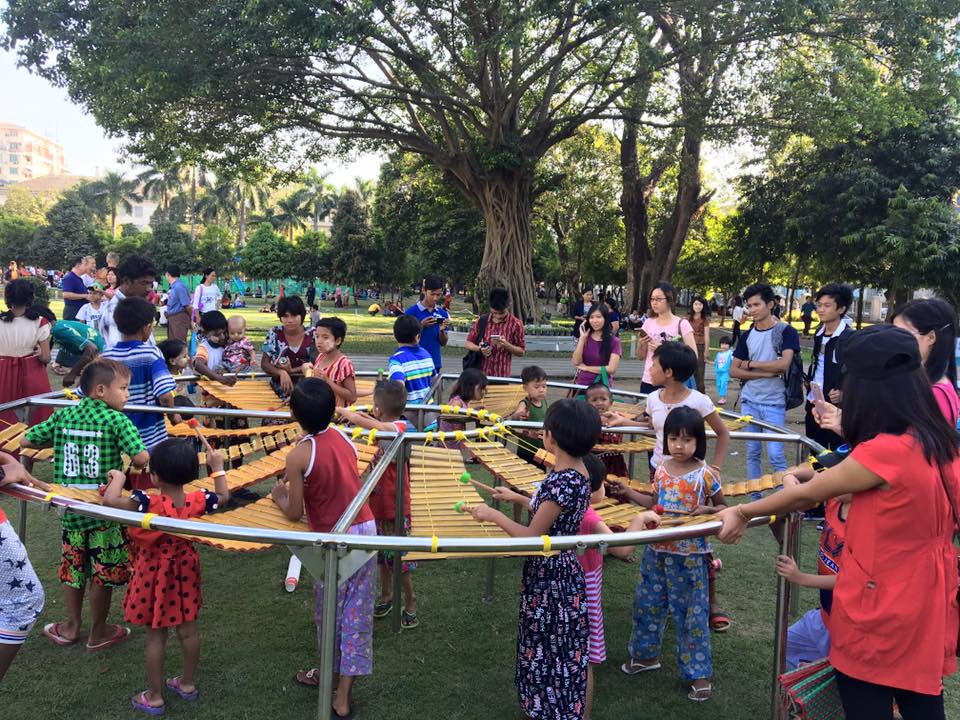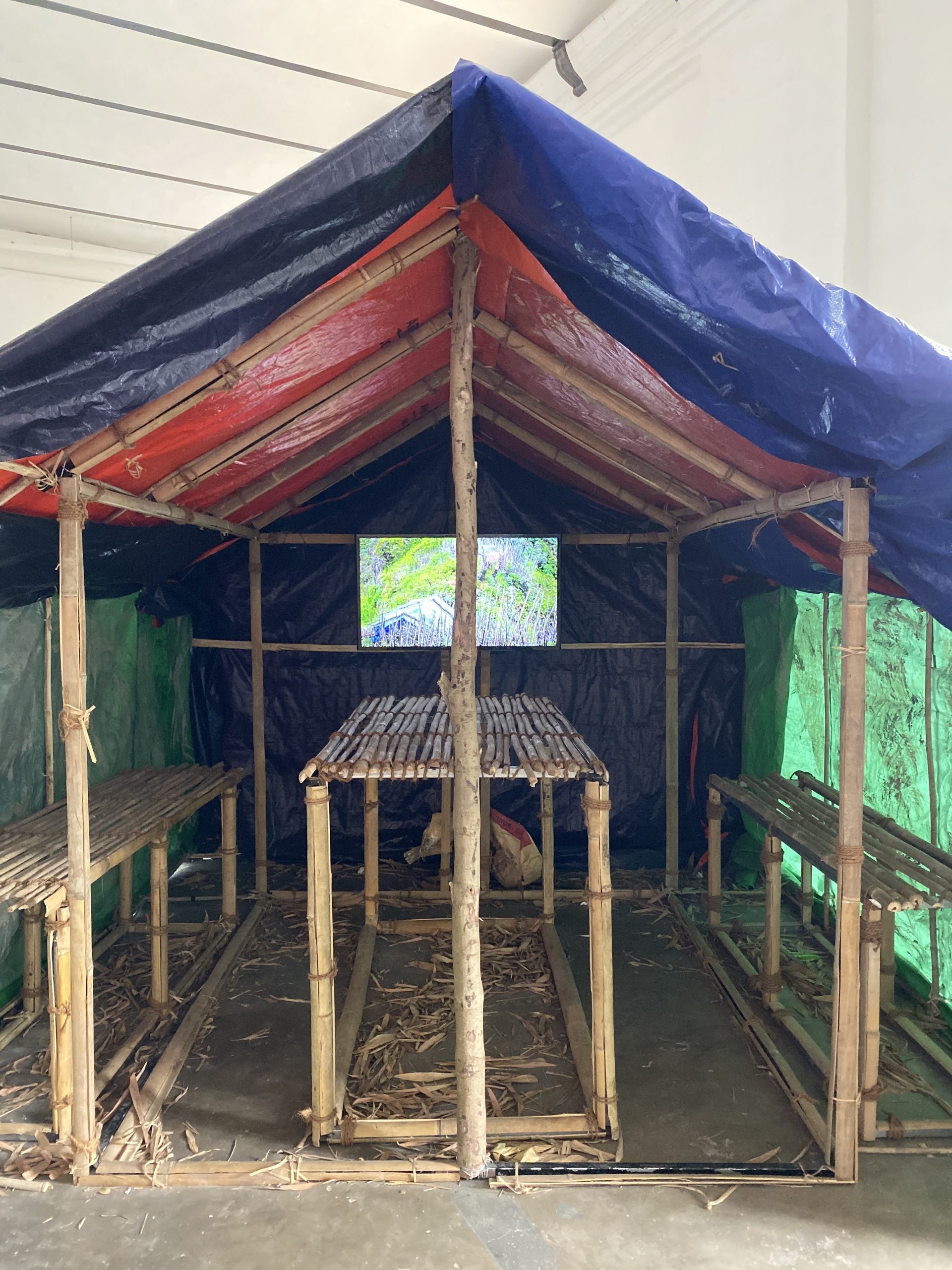Why have there been no Great Myanmar Contemporary Artists?
by Phoo Myat Thwe
Myanmar Contemporary Artists have long been accused of being raw, unimaginative, stuck in the past and stuck in portraying. the imagery of blood, gore, suffering, loss and violence in talking about the traumas they have experienced under Military dictatorship for several decades. There is no denying that there is some truth to this assessment, evidently most performance artists who concern themselves with blood, mess and struggles till today, and less with reconciliation, critical thinking, posing questions/ solutions. However, I am going to further argue here that a conversation about why Myanmar Contemporary Art is “not so great” or “stuck in the past” has to also be a conversation about demands and reactions from various stakeholders, spaces the artists have been given, the dialogues they have been involved in (or not involved in), and the narratives that they have been put and seen under. In addition, I am going to further discuss whether this repeated narrative of “stuck in the past” is actually true to this day. Further elaborations below will consist of references to the article “On Myanmar Art during Spring Revolution 2021” by Diana Zaw Win (You can read their article here), my counter arguments against some of the claims in it and my personal reflections and observations of the Myanmar Contemporary scene.
In the beginning of the article, “On Myanmar Art during Spring Revolution 2021”, Diana Zaw Win discussed how Trauma Art in Myanmar has been awkward and stuck with grotesque imagery to survive in the international art scene,
“Trauma art of Myanmar is awkward, because in order for it to survive in the international arena, it is obligated to condense its heavy content into a few short descriptions and time-limited presentations. This also imposed an immense burden on the artists as the story of the past seemed endless: a twenty-minute performance art will never be enough to cover a century-long story of trauma to an audience who has little or no knowledge of the country and circumstances in question. The contemporary art world of Myanmar has been trapped in a never-ending cycle of displaying grotesque themes to garner compassion and recognition from the international community. For a nation so isolated, this portrayal of the Burmese condition seemed to be the only way to not be forgotten by the world.”
They further claimed that the art of Spring Revolution 2021 is a shift from this “never-ending cycle”,
“What has happened during the Spring Revolution of 2021 was that this dependency on an external savior changed especially amongst the younger generations. This zeitgeist is promptly manifested in artworks created during this time.” They then went on to discuss how this shift has reconciled Myanmar Art with its past and is “fostering hope towards a deserving brighter future.”
What doesn’t work for me in this article are the following :
- The writer’s constructed narration of an extreme turn-around in the art scene in Myanmar, that supposedly happened during the Spring Revolution, has resulted in a very simplified, contorted version of what is actually taking place, ignoring the various past advances that have led to or enabled this crucial moment in Myanmar Contemporary Art History and failed to critically assess what is it that can happen afterwards when the high is gone.
- The writer has unfortunately repeated a tiring narrative of an exotic Myanmar and its unruly barbarians who just discovered “fire”.
To further discuss the question of ‘Why have there been no Great Myanmar Contemporary Artists?’, and to elaborate my claims towards the article, we have to look at the timeline of Myanmar Contemporary Art Scene outside of what is presented in this article. Diana Zaw Win has not discussed what has caused the progression from point A to B, compared in their article. It’s also needed to point out that the two art worlds they have compared in this article, one with grotesque images starving for international attention and another championing the people, are two different sectors that originate, transform and grow quite independently from one another and cannot be seen as an overall view of Myanmar Contemporary Art.
What particularly interests me in Diana Zaw Win’s article are the phrases, “The contemporary art world of Myanmar has been trapped in a never-ending cycle of displaying grotesque themes to garner compassion and recognition from the International community” and “…dependency on an external savior…”. This is a dangerous assumption, taking the characteristics of a very common obscured outsider view of Myanmar art scene, which doesn’t do justice to many of the artists who have been active in the scene then and now. There is perhaps some truth to the writer’s assessment of Myanmar art only ‘catering to international audience’ if it’s applied to an era of heavy censorship before democracy, art being expressed freely only in diplomatic spaces and it rather having to find ways to creatively evade the ever-changing rules of censorship if it wants to be exhibited in art spaces. (Here I am trying to understand the perspective of the writer. Whether the art of those days really catered just to international is up for dispute.) The opportunities to express are rare and there is much to express. The spaces where they can express most truthfully are where international folks reside.
Now this is where the question of demand comes in. We have to ask who was facilitating the artists to go beyond trauma and who was actually interested in the other stories they have to tell or actually had a conversation with artists that are telling other stories during those times. Lack of a facilitator or curator (though there are some artist-curators) in the scene might be one of the factors that contribute to the repetitive narratives of the oppressed the artists are telling. Still, we do have to draw our attention to the international community (curators, institutions, galleries) that interacted with the artists (do note that it’s with around 10-20% of the whole community) during those time with the intention that they want to give them space to talk about what’s happening in Myanmar, asking them to tell the stories of the oppressed that the artists are not able to tell inside the country. Years after democracy and art taking its various forms in Myanmar, the same interaction is happening from outside to inside. There is much contemplation needed on who is trapping the artists in this “never-ending cycle” that the writer has mentioned in their article. Is it really just the artists who are responsible for breaking through this narrative or is it the stakeholders who are demanding the artists to tell them the same stories they have told time after time, who is trapping the artists in the “Burmese condition”?
What has been demanded of Myanmar Contemporary Artists as the age of Democracy dawned on the country is to tell the same stories they have told outside inside the country. In a way, this was necessary. With the help of cultural institutions, external funding and collective efforts, many exhibitions bring historically important works and conversations to Myanmar public and governmental stakeholders, who are indifferent to these expressions and used to the knowledge that art is nothing but expressed through traditional mediums of painting, sculptures, dance and music. This step helped in integrating contemporary expressions and dialogues to the general public and this established position helped artists to further interact with the public in later festivals and exhibitions. Art in Myanmar has since progressed from ‘catering to International’ to ‘catering to public’. Artists want to move on and do things differently. Space is such a critical issue in this matter. Who gives space for Myanmar Artists to process their thoughts, their traumas and shift their practices? New blood coming into the scene is also bringing fresh perspectives and practices, differing from the ones that have been trapped in “Burmese condition” willingly or unwillingly. Also important to note that, if the international art scene has been trapping Myanmar artists in the Burmese condition, the home ground was no better. There are certain foreign cultural institutions in Myanmar who have tokenized Myanmar artists in their hybrid shows to push certain agendas, without giving the local artists much space for alternative expressions.
Before we look at the artworks of Spring Revolution 2021 critically, we have to look at what has happened in the recent years in Myanmar Contemporary Art to understand what has enabled Art to be people’s champion at this moment and how long can this public positive sentiment last. It’s true that Spring Revolution is the first revolution where Art took an active role, though further research is needed on this statement as there’s a possibility of art always being there with the public in revolution periods, but was not broadly introduced due to limiting publication structures. The “younger generation”, that Diana Zaw Win mentioned in their article, didn’t make a sudden appearance during Spring Revolution 2021, but has been initiators of an alternatively thriving art scene. Cheaper and freer internet access in Myanmar has enabled an age of digitalization and created exponential changes in its social conditions during a decade of Democracy. Contemporary art in gallery spaces might have struggled to connect with the public but art in digital spaces has always been with the public to respond to timely issues, create critical conversations and provoke certain groups to respond to them. The Facebook world of Myanmar helps accelerate this condition. This is a world that has stood independently from contemporary art on the gallery walls and they might find themselves not relating to the narratives their predecessors are in. Art is not coming just from traditional painting mediums, or ‘contemporary art’ that galleries are representing anymore. It’s from commercial digital artists who use social media as a portfolio platform. It’s from normal citizens who create memes to comment on, discuss many issues. It’s from photojournalists who are dabbling in contemporary photography to create alternative expressions from politics. Art in this space has been about identity politics, trauma, dealing with trauma, feminism, gender issues, environmental issues, community caring and responding, etc. In the past 2-3 years, efforts have been made to exhibit some of the works that emerged from the digital world in gallery spaces.

“The world: wet and disgusting”
“Thwe: I love Yaw Ni (I love Vagina)”
16’96 concept is a furniture store which joins in the debate for usage of the word ‘Yaw Ni’ in public by posting women empowerment cartoons on their Facebook Page. This cartoon is a satire comment against a famous Burmese male author who criticised the word ‘Yaw Ni’ by calling it wet and disgusting.
From the series “Thwe vs. The Whole World (တလောကလံးုနသဲ့ ွယ်)” by Thee’ Oo in collaboration with 16’96 concept, 2019.
And what of the old members of the contemporary art world that could not shake off the curse of ‘Burmese condition’? Perhaps not exhibited much internationally, some of these artists have put effort to engage with the public in their practices, most evidently in the works they have done in the last 2/3 years in local festivals and exhibitions. Artists have been experimenting with different mediums and are interested in expanding their own practices rather than being stuck in the past. These advances in both worlds intersected in Spring Revolution and have contributed to kickstart this “zeitgeist” of revolution artworks. The shift from ‘international attention’ to ‘local’ has been happening since before the Spring Revolution.


Now here is where I am going to sound very different from the writer’s optimistic assessment of Myanmar Contemporary Art’s future. The public positive sentiment and acceptance towards art during this Spring Revolution time is unmatched to any other time in history. That is undisputed. However, so far within these 6 months, most old and young generation of artists are responding to the socio/political conditions of Myanmar with individual reactions of satire, disgust, denouncing, provoking and rallying they have done so well in the past. The works are quick, reactionary works; timely commenting, reacting, enraging on the event progressions. Though such expressions are needed, there is room for more different forms. Keep in mind that though revolution art was rampant in the streets during massive protests in the early months of the coup, the interaction has been mostly in the digital world as the protests died down. Likes, dislikes and shares with people’s own interpretation captions are still public interactions, but can art not take any more form than poking the people on Facebook to remember about justice and freedom they so desperately want but afraid to express in the face of brutality? What can art do more? Can it teach people about recovery? Another important point is that those who are leading this art movement are not artists who see themselves in the contemporary art world but the people; the digital artists, the crafters, the gamers, the streamers. Art in Myanmar is changing exponentially faster than those who are in the art world can grasp. When the public wants more, can the artists of the contemporary art world provide more? The question of “Has Myanmar art reconciled with the past and moved towards a better future?” is still open for interpretation. The political conditions of Myanmar have been dragged back to the last 7 decades. The artists are again exiled, underground, thrown to jail, bound to face heavy censorship. The international community is perhaps also at risk to interact with Myanmar the same biased way they have during the ‘dark ages’. This is exactly this moment that new narratives and dialogues are needed to come in and is imperative that they do now if Myanmar Art doesn’t want to be doomed to echo the past. The art of Myanmar exists in many sectors independently. The tools and skills available to each sector are different. Artists from all sectors need to come together to talk, combine forces and think differently from the past on how they are going to continue their practices.
What we need, per my observation as a cultural worker in Myanmar, is space for conversations. How do we avoid the pitfall of continually talking about the swirling trauma that never left us? What other narratives can we tell ourselves? How do we collectively heal? How do we facilitate each other to heal? Do we go back into each own dark corner and contemplate our sufferings or do we come together to strategize impactful collective working and directions we can take? The answer for the last question has been taking place in many ways during this Revolution. Most notably are artists’ street in downtown Yangon, which sold art to protestors and raised money to support Civil Disobedience Movement, and a collective response against the coup with various drawings of the 3 fingers salute that made up an enormous NFT that is being sold now. But we do need more. Further working from this point of departure would be conversations about fostering a community of healing and caring, developing codes/ manifestos of conducts of care to better respond to long-standing political struggles in/ with Art; community as in not just the art folks but the country and its people as whole, thinking about how Art can be utilized to foster conversations and heal communities. There are a few artists who are already in that arena.
Why have there been no great Myanmar Contemporary artists? What this question demands is a tackling from various stakeholders in the cultural field, posing crucial additional questions about bias, spaces, relationships, resources, and creating critical dialogues that could help Myanmar cultural workers imagine a collective future together that is away from the narrative they have been jammed into for many decades, despite the fact that the political situation has been back to ground Zero. There have been great Myanmar Contemporary artists and there is space for even greater ones if the observers would stop putting them under a single narrative of traumatized beings and nothing more. This period in Myanmar History is a dichotomous time of being dragged into the past on one end and individuals who are still familiar with the taste and benefits of democracy on the other, whose eyes cannot be easily covered. Offered the opportunities, these individuals are ready to engage in crucial dialogues of what their collective future should look like and how they can get there.
What can you do to help make Myanmar Contemporary Art greater? Here are some suggestions.
- Concern yourself with more than seasoned artists whose names you can google.
- Engage yourself with young experimental artists who have yet to “mature” but are deserving of space to tell their stories.
- Create and offer opportunities to the younger generation of cultural workers.
- Facilitate dialogues.
- Stop asking artists to just be political. They are more than that. Approach the artists to let them tell their stories. Not you asking them to tell what you want to hear.
- Do not tokenize the artists.
- Most importantly, take yourself away from lazy assumptions that Myanmar is a mysterious country with a dark past and its people are away from global conversations. Before you assume, talk to actual people in/from Myanmar, give them space to enlighten, contribute to your knowledge.
